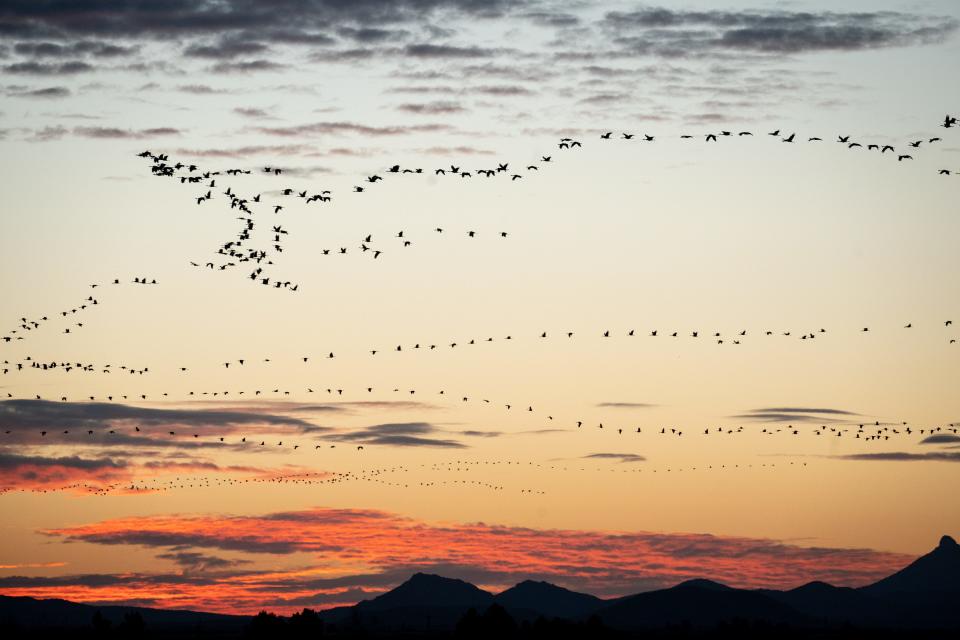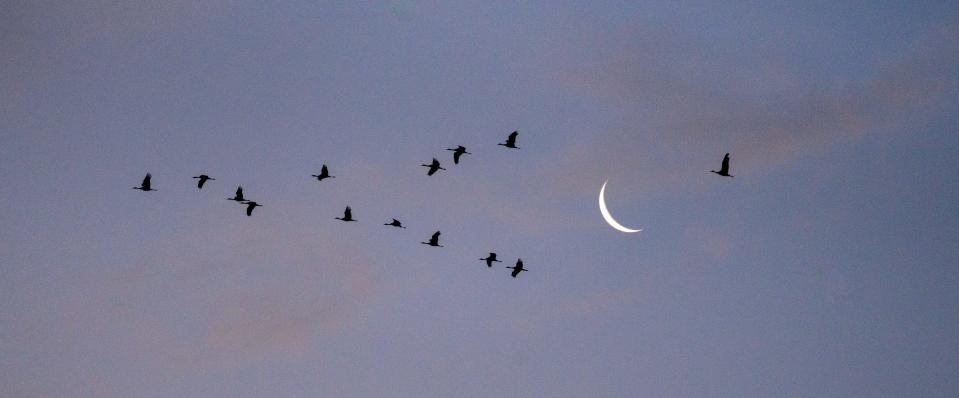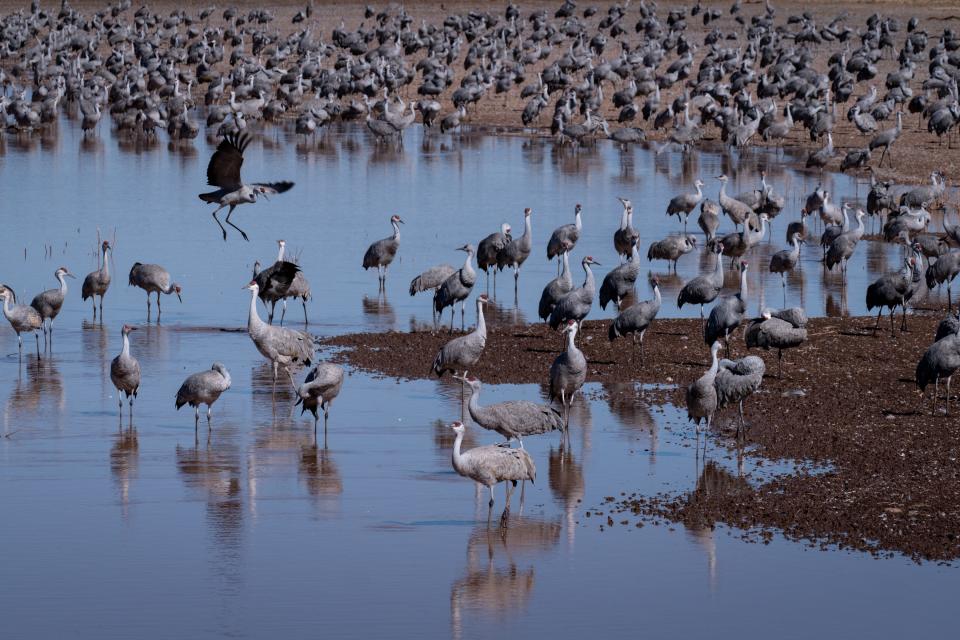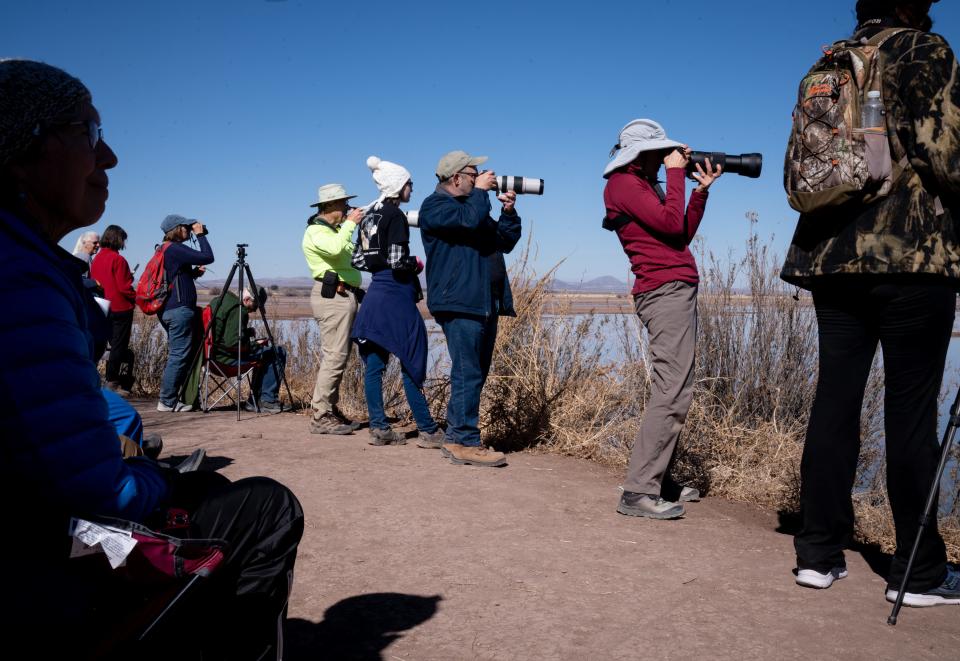Thousands of Sandhill cranes will migrate to Arizona this winter. Here's how to watch them
As winter approaches, snowbirds are beginning their annual migration to Arizona for more temperate weather. But it's not just the people from northern states escaping snowed-in homes. These are actual birds who flock to southern Arizona for the season.
Sandhill cranes are migratory birds that spend their winters in the southern states. Every year, about 40,000 to 50,000 cranes descend on the Sulphur Springs Valley to roost until spring. Between 20,000 and 25,000 of the cranes settle in the Whitewater Draw Wildlife Area, creating a popular bird-watching experience for in-person and remote viewers.
The Arizona Game and Fish Department has launched its annual Sandhill crane livestream from the draw, allowing viewers to observe these avian visitors throughout the season.
Here’s what to know about Sandhill cranes’ migration and AZGFD’s live stream:

When do Sandhill cranes migrate to southern Arizona?
After traveling hundreds of miles from the north, Sandhill cranes will make their grand entrance to the Sulphur Springs Valley starting this month. Between their six-foot wingspans, v-shaped flight patterns and horn-like calls, Sandhill cranes are hard to miss and a sight to behold.
“The birds have started to return, there are some on the camera right now,” said Jeff Meyers, a wildlife viewing program manager for AZGFD. “The peak numbers of birds will be in December and January.”
He estimates around a thousand cranes have arrived to the draw so far.
Three subspecies from the northern Rockies, the Canadian Rockies and over the North Pole in Siberia come to Arizona for the season. The cranes remain in southern Arizona until late February or mid-March.
In the spring, they return to their northern nesting grounds. The cranes typically lay one to three eggs each breeding period in April and May.
Sandhill cranes are one of the oldest surviving bird species. Experts have discovered Sandhill crane fossils that are estimated to be 2.5 million years old in Florida.
They estimate cranes have been migrating between breeding and roosting grounds across North America for thousands, if not millions, of years. During the winter months, they can also be found in Texas, California, New Mexico and Mexico.

Annual migration: Sandhill cranes flock to southern Arizona, giving nature buffs a 'magnificent sight'
Why do Sandhill cranes migrate to Arizona?
The Sulphur Springs Valley offers a plentiful habitat for Sandhill cranes, making it a popular winter roosting destination for the species.
The cranes are drawn to warmer weather and the bountiful food supply from nearby agriculture. Depending on their location throughout the year, the birds adjust their diets to available foods. They consume plants, grains, invertebrates, and small mammals, amphibians and reptiles.
“The birds come from a pretty harsh environment. They come here to build up energy for the breeding season and build up the reserves, and then they go back to the northern reaches where it’s much more comfortable for them in the summertime,” Meyers said.
They prefer wetland habitats with open land, making potential predators like coyotes, cougars and bobcats easy to spot from a greater distance.
The birds nest in marshes, bogs, wet meadows and prairies with standing water. Water from the surrounding mountains drains into the Sulphur Springs Valley, creating the ideal winter habitat for cranes.
While populations declined in the first half of the 20th century, they rebounded after protections were placed on wetlands and farmland expansion helped provide ample food supplies. The current population in North America is around 800,000 birds.
Although Sandhill cranes are a game species and can be hunted, officials prohibit hunting cranes in the draw during the winter, creating a safe haven for the visiting population.

How do you watch the Sandhill cranes online?
Viewers can watch thousands of cranes lounge in the draw or take flight to forage during the uninterrupted live stream. It attracts thousands of viewers from around the world every year.
To tune in, bird watchers can visit the AZGFD webpage dedicated to the crane cam.
Like their migratory patterns, the cranes' daily schedule is regimented. The best time to spot the birds during the live stream is around sunrise and late morning.
Just after sunrise, the cranes take off to forage in the surrounding fields. Around noon, viewers can watch the birds land as they return to the draw to rest. Cranes usually remain in the draw for the rest of the day, with some flocks occasionally departing and landing.
“The main reason we do this is to give people an intimate glimpse into the daily lives of wildlife from the comfort of their own home,” Meyers said. “An educated populace tends to be a passionate populace, and that’s the program’s goal to create wildlife advocates that are passionate about wildlife conservation.”
For bird watchers who want a closer look, the draw is open to the public with no fee to visit. Meyers encourages visitors to arrive north of the draw 30 minutes before sunrise during December and January for the best views.
“In my opinion, it’s the single best wildlife viewing experience in the entire state of Arizona,” he said. “You’ll see tens of thousands of cranes flying in V formation against the light sky of dawn. The cacophony of sound that they make is really something to behold.”

Hayleigh Evans covers environmental issues for The Arizona Republic and azcentral. Send tips or questions to hayleigh.evans@arizonarepublic.com.
Environmental coverage on azcentral.com and in The Arizona Republic is supported by a grant from the Nina Mason Pulliam Charitable Trust. Sign up for AZ Climate, our weekly environment newsletter, and follow The Republic environmental reporting team at environment.azcentral.com and @azcenvironment on Facebook, Twitter and Instagram.
You can support environmental journalism in Arizona by subscribing to azcentral.com today.
Watching birds: Tens of thousands of sandhill cranes return to southern Arizona for the winter
This article originally appeared on Arizona Republic: Sandhill Cranes begin annual migration to Southern Arizona marshes

